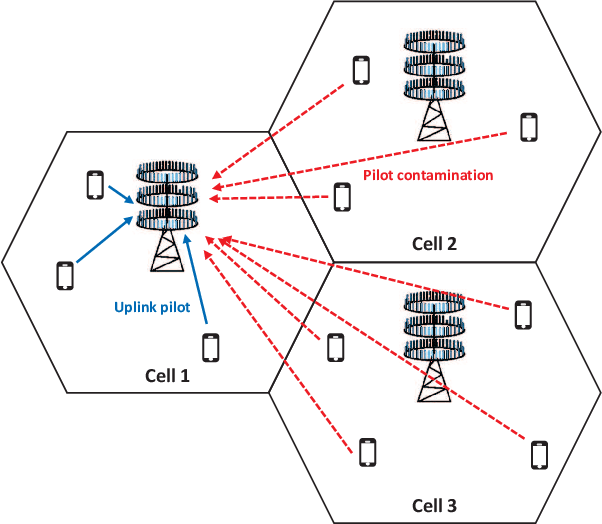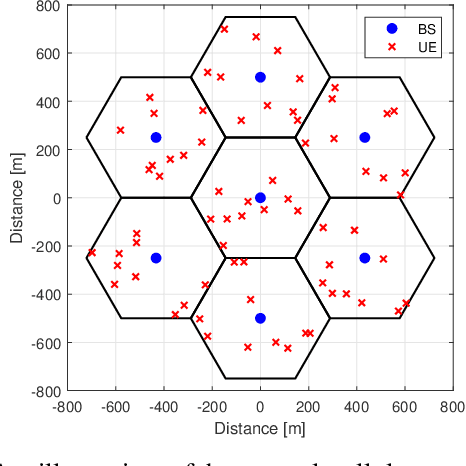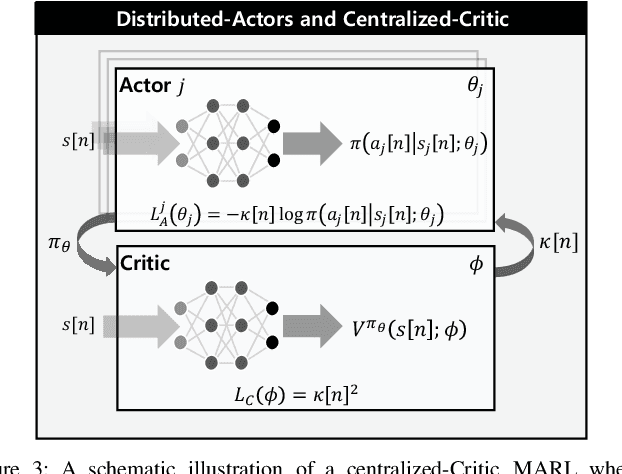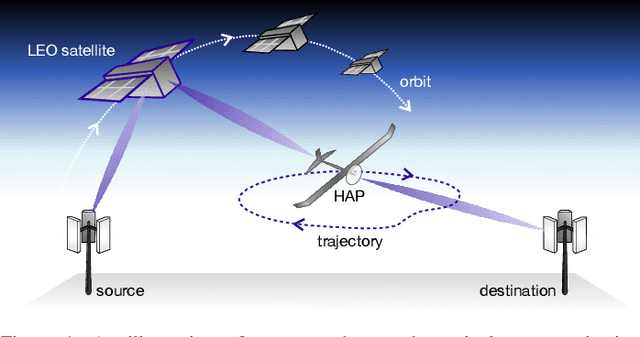Young-Chai Ko
Learning Emergent Random Access Protocol for LEO Satellite Networks
Dec 03, 2021



Abstract:A mega-constellation of low-altitude earth orbit (LEO) satellites (SATs) are envisaged to provide a global coverage SAT network in beyond fifth-generation (5G) cellular systems. LEO SAT networks exhibit extremely long link distances of many users under time-varying SAT network topology. This makes existing multiple access protocols, such as random access channel (RACH) based cellular protocol designed for fixed terrestrial network topology, ill-suited. To overcome this issue, in this paper, we propose a novel grant-free random access solution for LEO SAT networks, dubbed emergent random access channel protocol (eRACH). In stark contrast to existing model-based and standardized protocols, eRACH is a model-free approach that emerges through interaction with the non-stationary network environment, using multi-agent deep reinforcement learning (MADRL). Furthermore, by exploiting known SAT orbiting patterns, eRACH does not require central coordination or additional communication across users, while training convergence is stabilized through the regular orbiting patterns. Compared to RACH, we show from various simulations that our proposed eRACH yields 54.6% higher average network throughput with around two times lower average access delay while achieving 0.989 Jain's fairness index.
Joint Pilot Design and Channel Estimation using Deep Residual Learning for Multi-Cell Massive MIMO under Hardware Impairments
Aug 10, 2021



Abstract:In multi-cell massive MIMO systems, channel estimation is deteriorated by pilot contamination and the effects of pilot contamination become more severe due to hardware impairments. In this paper, we propose a joint pilot design and channel estimation based on deep residual learning in order to mitigate the effects of pilot contamination under the consideration of hardware impairments. We first investigate a conventional linear minimum mean square error (LMMSE) based channel estimator to suppress the interference caused by pilot contamination. After that, a deep learning based pilot design is proposed to minimize the mean square error (MSE) of LMMSE channel estimation, which is utilized to the joint pilot design and channel estimator for transfer learning approach. For the channel estimator, we use a deep residual learning which extracts the features of interference caused by pilot contamination and eliminates them to estimate the channel information. Simulation results demonstrate that the proposed joint pilot design and channel estimator outperforms the conventional approach in multi-cell massive MIMO scenarios. Furthermore, the joint pilot design and channel estimator using transfer learning enhances the estimation performance by reducing the effects of pilot contamination when the prior knowledge of pilot contamination cannot be exploited.
Joint Association and Resource Allocation for Multi-Hop Integrated Access and Backhaul (IAB) Network
Aug 10, 2021



Abstract:Integrated access and backhaul (IAB) network is envisioned as a novel network architecture for increasing the network capacity and coverage. To facilitate the IAB network, the appropriate methods of wireless link association and resource management are required. In this paper, we investigate the joint optimization problem of association and resource allocation in terms of subchannel and power for IAB network. In particular, we handle the association and resource allocation problems for wireless backhaul and access links considering multi-hop backhauling. Since the optimization problem for IAB network is formulated as a mixed integer non-linear programming (MINLP), we divide it into three subproblems for association, subchannel allocation, and power allocation, respectively, and these subproblems are solved alternatively to obtain a local optimal solution. For the association problem, we adopt the Lagrangian duality approach to configure the backhaul and access links and successive convex approximation (SCA) approach is used to solve the subchannel and power allocation problems efficiently. Simulation results demonstrate that the proposed algorithm achieves better performance than single-hop backhauling based network and enhances the capacity and coverage by configuring the multi-hop backhauling.
Attention-based Reinforcement Learning for Real-Time UAV Semantic Communication
May 22, 2021



Abstract:In this article, we study the problem of air-to-ground ultra-reliable and low-latency communication (URLLC) for a moving ground user. This is done by controlling multiple unmanned aerial vehicles (UAVs) in real time while avoiding inter-UAV collisions. To this end, we propose a novel multi-agent deep reinforcement learning (MADRL) framework, coined a graph attention exchange network (GAXNet). In GAXNet, each UAV constructs an attention graph locally measuring the level of attention to its neighboring UAVs, while exchanging the attention weights with other UAVs so as to reduce the attention mismatch between them. Simulation results corroborates that GAXNet achieves up to 4.5x higher rewards during training. At execution, without incurring inter-UAV collisions, GAXNet achieves 6.5x lower latency with the target 0.0000001 error rate, compared to a state-of-the-art baseline framework.
Integrating LEO Satellites and Multi-UAV Reinforcement Learning for Hybrid FSO/RF Non-Terrestrial Networks
Oct 20, 2020



Abstract:A mega-constellation of low-altitude earth orbit (LEO) satellites (SATs) and burgeoning unmanned aerial vehicles (UAVs) are promising enablers for high-speed and long-distance communications in beyond fifth-generation (5G) systems. Integrating SATs and UAVs within a non-terrestrial network (NTN), in this article we investigate the problem of forwarding packets between two faraway ground terminals through SAT and UAV relays using either millimeter-wave (mmWave) radio-frequency (RF) or free-space optical (FSO) link. Towards maximizing the communication efficiency, the real-time associations with orbiting SATs and the moving trajectories of UAVs should be optimized with suitable FSO/RF links, which is challenging due to the time-varying network topology and a huge number of possible control actions. To overcome the difficulty, we lift this problem to multi-agent deep reinforcement learning (MARL) with a novel action dimensionality reduction technique. Simulation results corroborate that our proposed SAT-UAV integrated scheme achieves 1.99x higher end-to-end sum throughput compared to a benchmark scheme with fixed ground relays. While improving the throughput, our proposed scheme also aims to reduce the UAV control energy, yielding 2.25x higher energy efficiency than a baseline method only maximizing the throughput. Lastly, thanks to utilizing hybrid FSO/RF links, the proposed scheme achieves up to 62.56x higher peak throughput and 21.09x higher worst-case throughput than the cases utilizing either RF or FSO links, highlighting the importance of co-designing SAT-UAV associations, UAV trajectories, and hybrid FSO/RF links in beyond-5G NTNs.
Integrating LEO Satellite and UAV Relaying via Reinforcement Learning for Non-Terrestrial Networks
May 26, 2020



Abstract:A mega-constellation of low-earth orbit (LEO) satellites has the potential to enable long-range communication with low latency. Integrating this with burgeoning unmanned aerial vehicle (UAV) assisted non-terrestrial networks will be a disruptive solution for beyond 5G systems provisioning large scale three-dimensional connectivity. In this article, we study the problem of forwarding packets between two faraway ground terminals, through an LEO satellite selected from an orbiting constellation and a mobile high-altitude platform (HAP) such as a fixed-wing UAV. To maximize the end-to-end data rate, the satellite association and HAP location should be optimized, which is challenging due to a huge number of orbiting satellites and the resulting time-varying network topology. We tackle this problem using deep reinforcement learning (DRL) with a novel action dimension reduction technique. Simulation results corroborate that our proposed method achieves up to 5.74x higher average data rate compared to a direct communication baseline without SAT and HAP.
 Add to Chrome
Add to Chrome Add to Firefox
Add to Firefox Add to Edge
Add to Edge